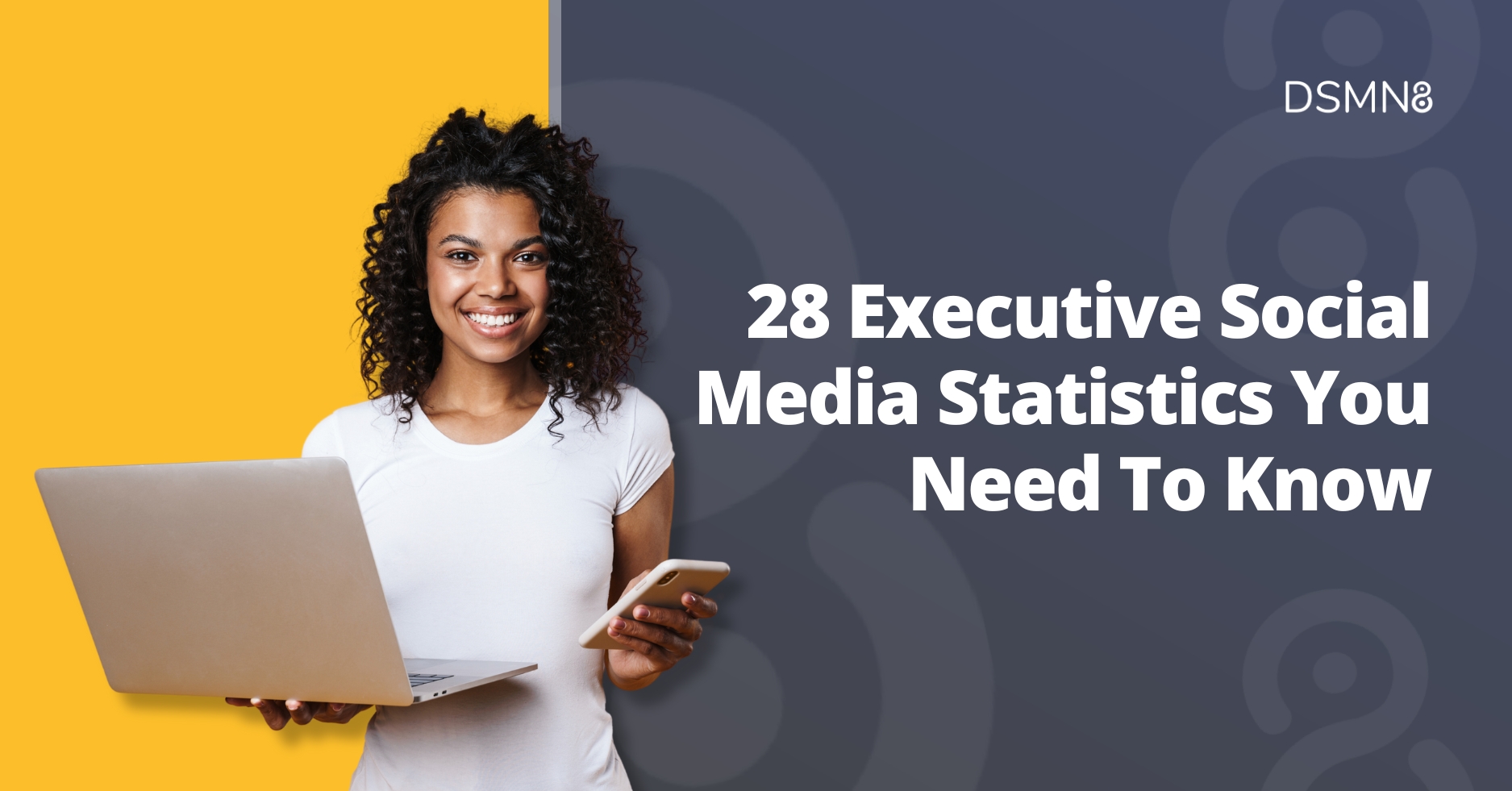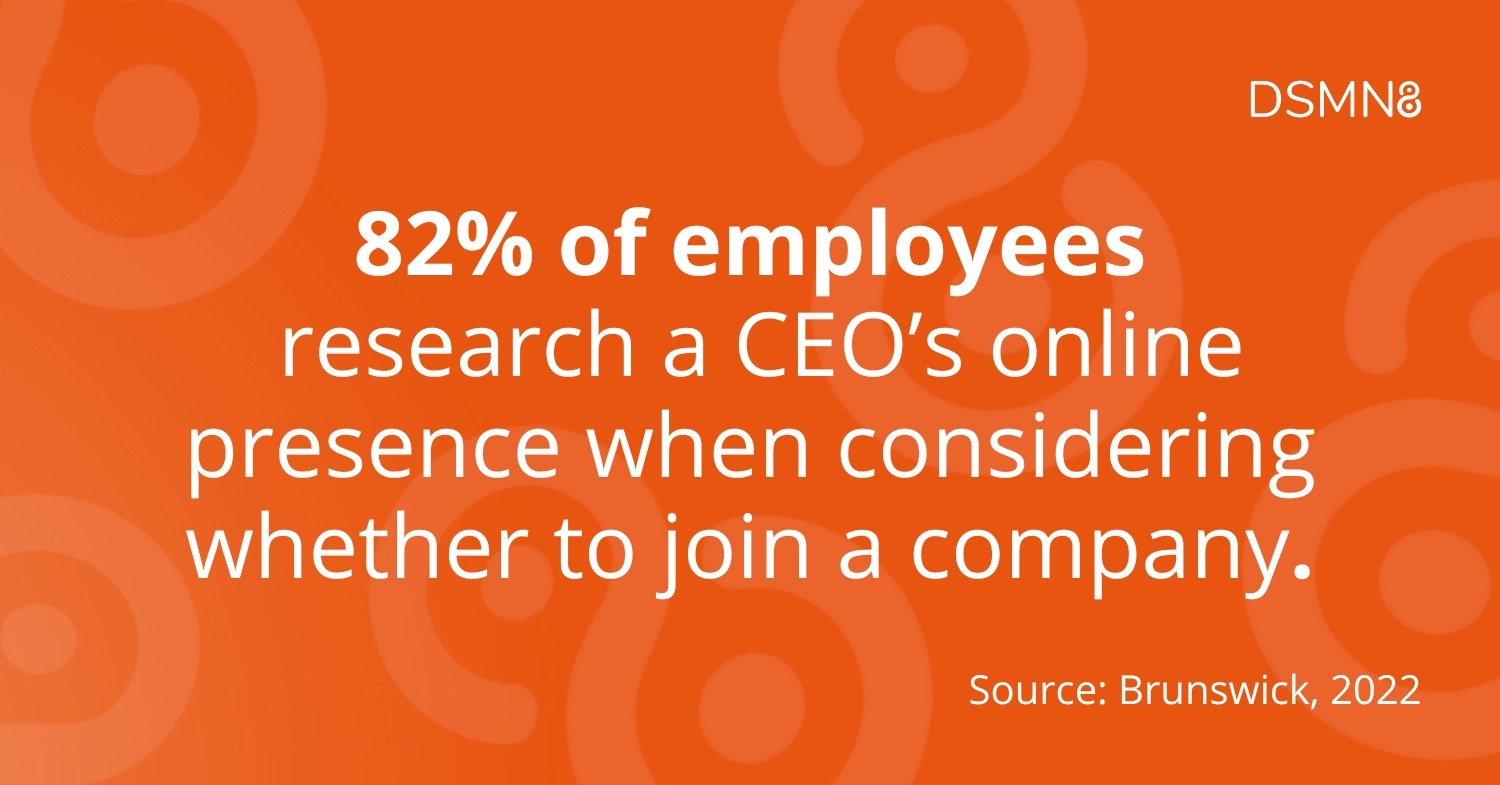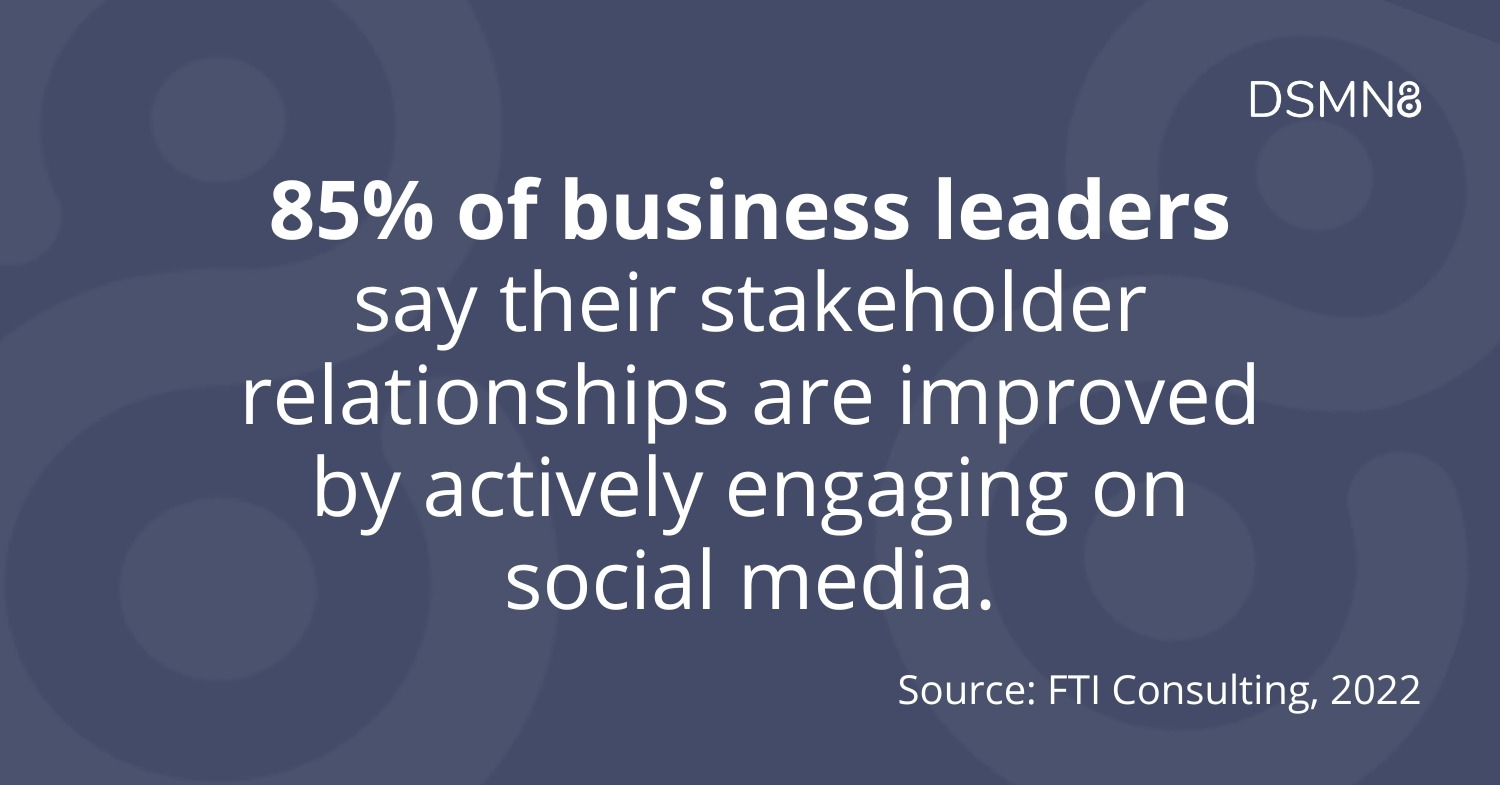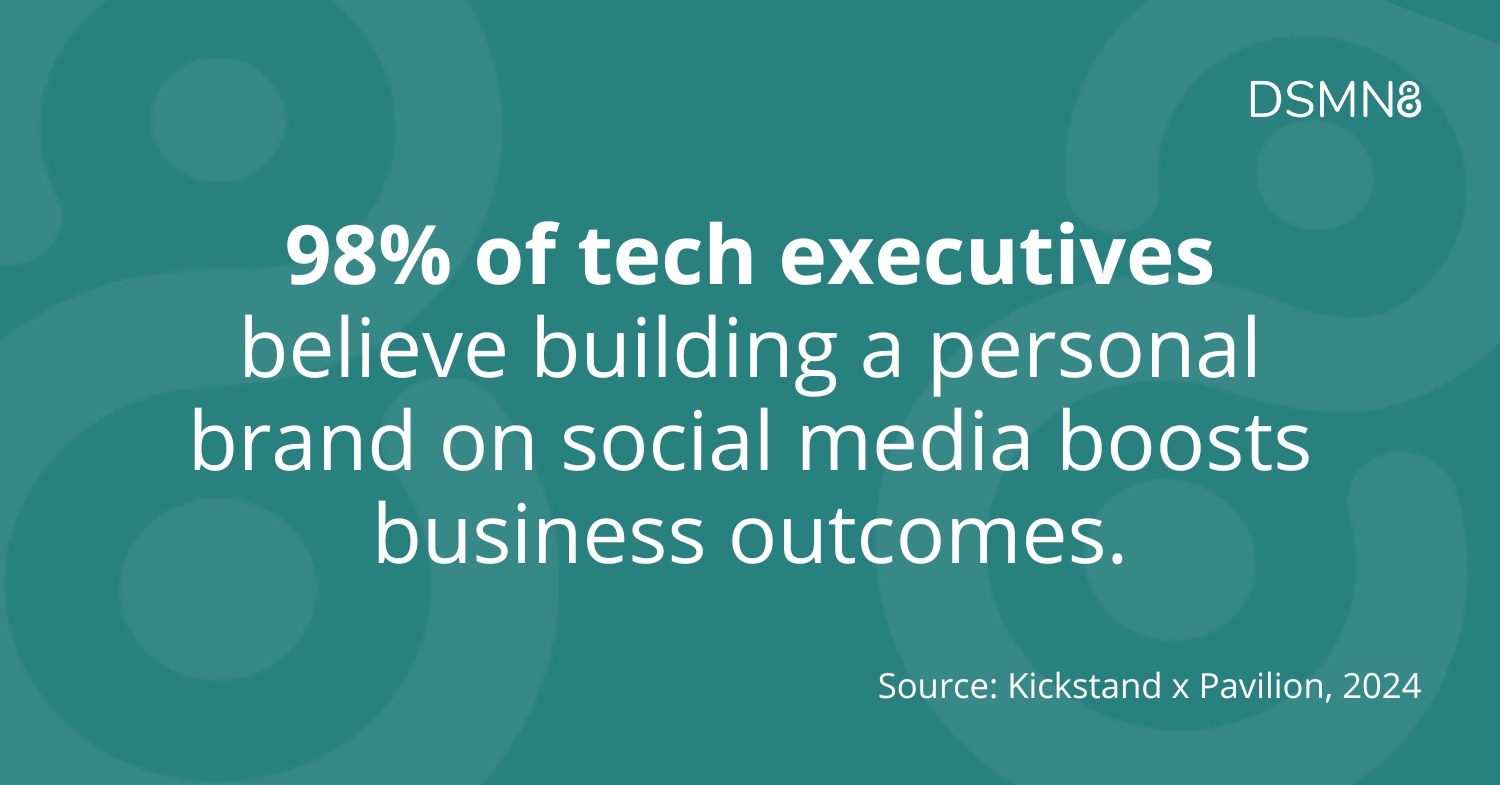
How are executives leveraging social media to build trust in their company?
How does a CEO’s social media presence impact recruitment, employee engagement, and business results?
And what challenges do senior leaders face when it comes to maintaining their social media presence?
To answer these questions, we’ve curated 28 key executive social media statistics from industry studies and reports.
These statistics reveal everything from how CEOs feel about social media to the primary benefits observed in organizations with executive influencers.

The Impact of Executive Social Media on Recruitment & Employee Engagement
Two areas where a CEO’s social media presence clearly makes a huge difference are talent acquisition and employee engagement.
Most candidates would prefer to work for leaders who are active on social media, going so far as to research a CEO online when considering applying for a role.
And that’s not all: the majority now expect leaders to communicate company values on social media.
- 82% of employees will research a CEO’s online presence when considering whether to join a company (Brunswick, 2022).
- 86% of executives who work with a social CEO considered their leadership “open and honest” (Weber Shandwick).
- People prefer to work for leaders who use social media 4x more than leaders who do not (Brunswick, 2022).
- Posts where CEOs highlighted employee accomplishments, leadership changes or employee-led philanthropy were 3x more likely to exceed engagement benchmarks on social media than any other topic (H/Advisors Abernathy, 2024).
- 82% expect leaders to use social media to communicate mission, vision, and values (Brunswick, 2022).
- 92% of professionals say they are more likely to trust a company whose senior executives are using social media (FTI Consulting, 2022).

The Effect of Executive Social Media on Business Outcomes
It’s evident that the social media presence of your executives influences company culture, from recruitment to employee retention.
But what about business results?
The statistics below reveal that leveraging a CEO’s social media is a strategic play for marketing and communications teams, generating significantly higher reach and engagement than company channels.
Business leaders agree that executive social media presence is important and improves stakeholder relationships. This also impacts consumer trust, as nearly 3/4 of consumers are more likely to purchase from a company whose CEO is active on social media.
-
90% of employee LinkedIn posts with the most reactions are by the CEO (DSMN8, Study of 11,107 Employee LinkedIn Posts, 2023).
-
51% of Global executives rate their company leaders’ presence on social media as very important (Weber Shandwick, 2020).
-
82% of business leaders agree there is a wider reward for the company if their leadership are active on social media (FTI Consulting, 2022).
-
71% of consumers are more likely to buy from a company if its CEO is active on social media (Edelman, 2024).
-
Executive statements shared online will earn more reach than those made in traditional news (H/Advisors Abernathy, 2024).
-
Financial readers trust a CEO who uses social media up to 9x more than one who does not (FTI Consulting, 2022).
- 64% of buyers say that thought leadership content is a more trustworthy basis for assessing a company’s capabilities and competency than its marketing materials. (LinkedIn).
-
A CEO generates the same amount of LinkedIn reactions as the company page, with 1.67% of the followers. (DSMN8, Study of 11,107 Employee LinkedIn Posts, 2023).
-
85% of business leaders say their stakeholder relationships are improved by actively engaging on social media (FTI Consulting, 2022).
Are your executives active on LinkedIn? How does this compare with your competitors? Find out with a free executive influencer competitor analysis review.

How Executives Feel About Social Media
It’s clear that social media is becoming increasingly important to executives, especially in sectors like Tech and Financial Services.
Unsurprisingly, the most popular social media channel among the C-Suite is LinkedIn, with both CEOs and CFOs being particularly active on the platform.
-
87% of FTSE 100 executive committee members have a LinkedIn presence (FTI Consulting, 2022).
-
98% of tech executives believe building a personal brand on social media boosts business outcomes (Kickstand x Pavilion, 2024).
-
89% of CFOs have a LinkedIn account and post at least once per month (H/Advisors Abernathy, 2024).
-
73% of CEOs on the 2023 Fortune 500 list are on at least one social media platform (Influential Executive, 2023).
-
Of the Fortune 500 CEOs that were on at least one social media platform, 98% of them use LinkedIn (Influential Executive, 2023).
-
54% of C-level execs spend an hour or more per week reading thought leadership content (Edelman, 2024).
-
48% of CEOs post on social media at least once per month (H/Advisors Abernathy, 2024).
- In 2022, there was a notable 85% increase in CEOs’ follower numbers, with each having an average of 30,000 or more followers (FTI Consulting, 2022).
-
53% of Financial Services CEOs are on LinkedIn, among the highest across industries. (H/Advisors Abernathy, 2024).
-
CEOs in the tech space have increased their social media participation significantly, doubling the number of accounts year-over-year (H/Advisors Abernathy, 2024).
How active are your executives on social media? Get a free health check to find out!

Challenges Executives Face in Maintaining a Social Media Presence
What are the main challenges executives are facing when it comes to social media?
Lack of time and expertise.
While C-level executives are often industry experts, they aren’t social media managers. The majority want support in building their personal brands, and as many as 1 in 5 would like all of their social media content created for them.
- Almost 85% of ASX200 chief executives are either ‘invisible’, ‘inactive’ or ‘ineffective’ on LinkedIn (Propel, 2022).
-
53% of CEOs not on social media have inaccuracies in their online search profile (H/Advisors Abernathy, 2024).
-
1/5 senior leaders would like all their social content to be written by an expert (FTI Consulting, 2022).
-
67% of senior business leaders want support from social media experts to drive their digital impact (FTI Consulting, 2022).
Ready to see how DSMN8 helps your executives build their presence on social media? Book a Demo.
Key Takeaways
It’s clear that the past few years have seen a big increase in C-level executives using social media to represent their organizations, sharing company news and thought leadership content to drive business results.
LinkedIn has emerged as the go-to social media channel for executives, with the majority of CEOs now actively posting on the platform.
Their content is reaching more people than traditional news media, making a CEO’s LinkedIn profile a key communications channel for company announcements.
The benefits of a ‘social CEO’ extend to recruitment, employee engagement, and retention. The majority of candidates research a CEO on social media before considering working for an organization, and employee-centered content generates 3x more engagement than any other topic.
But it’s not all about the CEO: research revealed that CFOs can wield huge influence on LinkedIn, too, taking some of the pressure off the CEO to be the organization’s sole spokesperson.
When it comes to managing their social media presence, CEOs are seeking support from social media teams to create content on their behalf and increase their visibility.
Employee advocacy program managers can support this by creating tailored content for executive influencers to share. To take this even further, leveraging an employee advocacy platform will streamline the content approval workflow and make it easy for executives to stay active on social media with minimal time requirements.
Additional Resources
Learn more about executive leaders on social media 👇
Ready to get started with the #1 employee advocacy platform?
Wondering how active your team already is, and how this compares with your competitors?
Emily Neal
SEO and Content Specialist at DSMN8. Emily has 10 years experience blogging, and is a pro at Pinterest Marketing, reaching 1 million monthly views. She’s all about empowering employees to grow their personal brands and become influencers.



